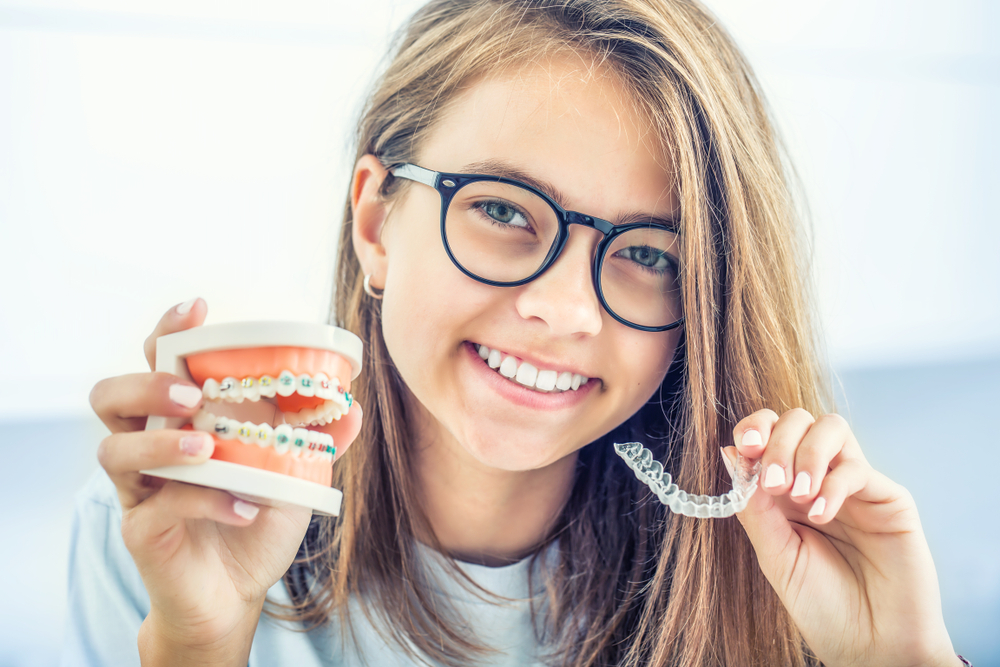Opening Hours
Mon-Fri: 9:00 AM - 5:00 PM
Sat: 9:00 AM - 5:00 PM
Call Us
(02) 7228 7272
Dentist Marrickville | True Smiles Dental

Historically the only method of correcting ones crowding, cross bite, deep bite, or underbite would require traditional orthodontic braces. They were the metal bars that you commonly saw on kids’ teeth at school during their teenage years. Fast forward to the present and the advancements of technology and understanding of tooth movements have introduced a new era of orthodontic correction, Invisalign – a popular option for patients that wish to correct their smile without the metal look on their teeth. Invisalign has fast become a popular treatment choice as it provides a great solution for both adults and teens without the cumbersome appearance of conventional braces.
Braces have long been used by general dentists and specialist orthodontists to correct smiles. They have corrected millions of smiles and still have a rightful place in Orthodontics. One of the biggest nuisances of conventional braces is that they are stuck onto your teeth, which can lead to various issues that many patients need to consider. We’ve listed a few issues that may arise from conventional braces:
It may seem that the above reasons are good enough to avoid conventional braces. Thankfully, the concerns listed above can be easily managed. One of the issues, the metal colour, have been solved by the introduction of ceramic braces. Ceramic braces are like your conventional metal braces, but instead of metal, the brackets are ceramic in colour. Ceramic brackets blend in with your teeth shade better and can improve the overall look when you smile during orthodontic treatment. Likewise with metal braces, they still result in difficulties with oral hygiene and increased risks of decay and periodontal disease.
For patients that wish to have braces but not have anything show when they smile, technology has created ‘lingual braces’. These are also known as ‘inside braces’, which are popular with patients that don’t want anything to appear on the front surface of their teeth. Although they are more subtle in appearance, they are just like braces and so one should maintain the strictest of oral hygiene regime during treatment. Lingual braces may be quite appealing due to their discreet nature, but they can affect your speech more so than conventional braces. As the lingual braces sit on the inside of your teeth, they are in direct contact with your tongue. This can lead to changes in speech, which will eventually improve with time. Tongue trauma is also common with lingual braces.
The introduction of Invisalign has allowed patients the opportunity to correct their smile and improve their bite without the need of metal braces affixed to your teeth. This has become increasing popular as teens and adults seek an improved smile without the look of metal braces. Invisalign’s discreet aligners gradually correct your teeth with reduced risks associated with conventional braces. Some of the benefits of choosing Invisalign include:
Some things to consider with Invisalign include:
No one treatment is better than the other. Depending on the amount of crowding, spacing, or bite, the treatment recommendations may differ. Technology has allowed us to correct smiles through a variety of means, and in some cases, a combination may be implemented. Once all options have been carefully explained and discussed, we can help you achieve that perfect smile. Whether your teeth are best suited for conventional braces or Invisalign, our goal is to ensure the best result for you and your teeth. Every case is different and treatment goals should consider your needs as the patient, and careful consideration of what treatment modality would be most successful. In some cases, a referral to an Orthodontist may be required due to the complexities involved. The team at True Smiles Dental assess your teeth regularly during your routine checkups. This allows us to identify possible issues, and suggest a timeframe for intervention. This is particularly important for growing children as orthodontic intervention can start in their early mixed dentition.
We’ve listed several reasons where conventional braces and Invisalign may benefit you to help give patients a better understanding of both treatment modalities. At True Smiles Dental, we strive to accurately assess your teeth and aid in guiding you to the best treatment option. Results are important and so both options should always be considered when it comes to achieving that perfect smile. The team at True Smiles Dental can help assist you on your teeth straightening journey. Call us on 02 7228 7272 or book online at https://truesmilesdental.com.au